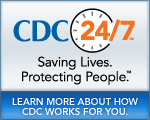MMWR
Morbidity and Mortality Weekly Report
MMWR News Synopsis for October 29, 2009
- Overdose Deaths Involving Prescription Opioids Among Medicaid Enrollees a€“ Washington, 2004-2007
- Perceived Insufficient Rest or Sleep Among Adults a€“ United States, 2008
- Cronobacter Species Isolation in Two Infants a€“ New Mexico, 2008
There is no MMWR telebriefing scheduled for October 29, 2009.
1. Overdose Deaths Involving Prescription Opioids Among Medicaid Enrollees a€“ Washington, 2004-2007
Press Contact: Timothy Church
Public information Officer, Washington State Department of Health
Phone: (360) 236-4077
This study highlights the prominence of methodone in prescription opioid deaths and indicates that Medicaid enrollees may be a high-risk group.?? During 1999a€“2006, the number of poisoning deaths in the United States nearly doubled, largely as a result of deaths involving prescription opioid painkillers. These increases in drug overdose rates paralleled a nearly four-fold increase in the use of prescription opioids during this period nationally. In 2006, the rate of poisoning involving opioid painkillers in Washington was significantly higher than the national rate. In Washington from 2004 to 2007, 1,668 people died of prescription opioid-related overdoses. Of those, 58.9 percent were male, 34.4 percent were 45a€“54 years of age, and 45.4 percent were Medicaid-enrolled. The Medicaid-enrolled population had a 5.7-fold increased risk of prescription opioid-related overdose death. Methadone was involved in almost two-thirds of these deaths. Efforts to minimize this risk should focus on assessing the patterns of opioid prescribing to Medicaid enrollees and intervening with Medicaid enrollees who appear to be misusing these drugs.
2. Perceived Insufficient Rest or Sleep Among Adults a€“ United States, 2008
Press Contact: CDC, Division of Media Relations
Phone: (404) 639-3286
An estimated 50-70 million Americans suffer from chronic sleep and wakefulness disorders. Sleep disorders and sleep loss have been associated with mental distress, depression, anxiety, obesity, hypertension, diabetes, high cholesterol and certain risk behaviors including cigarette smoking, physical inactivity and heavy drinking.?? A new report from the CDC found that?? data collected from adults in all 50 United States, DC, and 3 U.S. territories found that 1 in 3 adults (30.7 percent) in 2008, reported no days of not getting enough rest or sleep in the past 30-days. However, 1 in 10 adults (11.1 percent)?? reported not getting enough rest or sleep everyday during the past month. Females (12.4 percent) were more likely than males (9.9 percent) and non-Hispanic blacks (13.3 percent) were more likely than other racial/ethnic groups to report not getting enough rest or sleep. State estimates of 30 days of insufficient rest or sleep ranged from 7.4 percent in North Dakota to 19.3 percent in West Virginia.??
3. Cronobacter Species Isolation in Two Infants a€“ New Mexico, 2008
Press Contact: Chris Minnick
Public Information Officer, New Mexico Department of Health
Phone: (575) 528-5197
Since powdered infant formula (PIF) is not sterile, breastfeeding, universal adoption of World Health Organization PIF preparation guidelines and continued improvement of PIF manufacturing processes might help reduce illness among infants.?? Cronobacter spp. (formerly Enterobacter sakazakii) cause infant septicemia and meningitis; approximately 40 percent of cases die. Although believed rare, Cronobacter spp. were isolated from two nonhospitalized infants in New Mexico in 2008. The only shared exposure for these infants was consumption of powdered infant formula, which is a known risk factor for Cronobacter infection. In this investigation, Cronobacter was not isolated from sealed canisters of formula, but was found in an opened canister of formula consumed by one infant.?? Powdered infant formula can be intrinsically or extrinsically contaminated with Cronobacter organisms; improved formula manufacture and packaging and safer preparation techniques could prevent Cronobacter infections among infants. Additionally, enhanced surveillance is needed to estimate the Cronobacter disease burden and provide insight into risk factors for illness.
####
- Historical Document: October 29, 2009
- Content source: Office of Enterprise Communication
- Notice: Linking to a non-federal site does not constitute an endorsement by HHS, CDC or any of its employees of the sponsors or the information and products presented on the site.
View Press Releases in
Get e-mail updates
To receive e-mail updates about this page, enter your
e-mail address:
Contact Us:
- Centers for Disease Control and Prevention
1600 Clifton Rd
Atlanta, GA 30333 - 800-CDC-INFO
(800-232-4636)
TTY: (888) 232-6348 - Contact CDC-INFO


